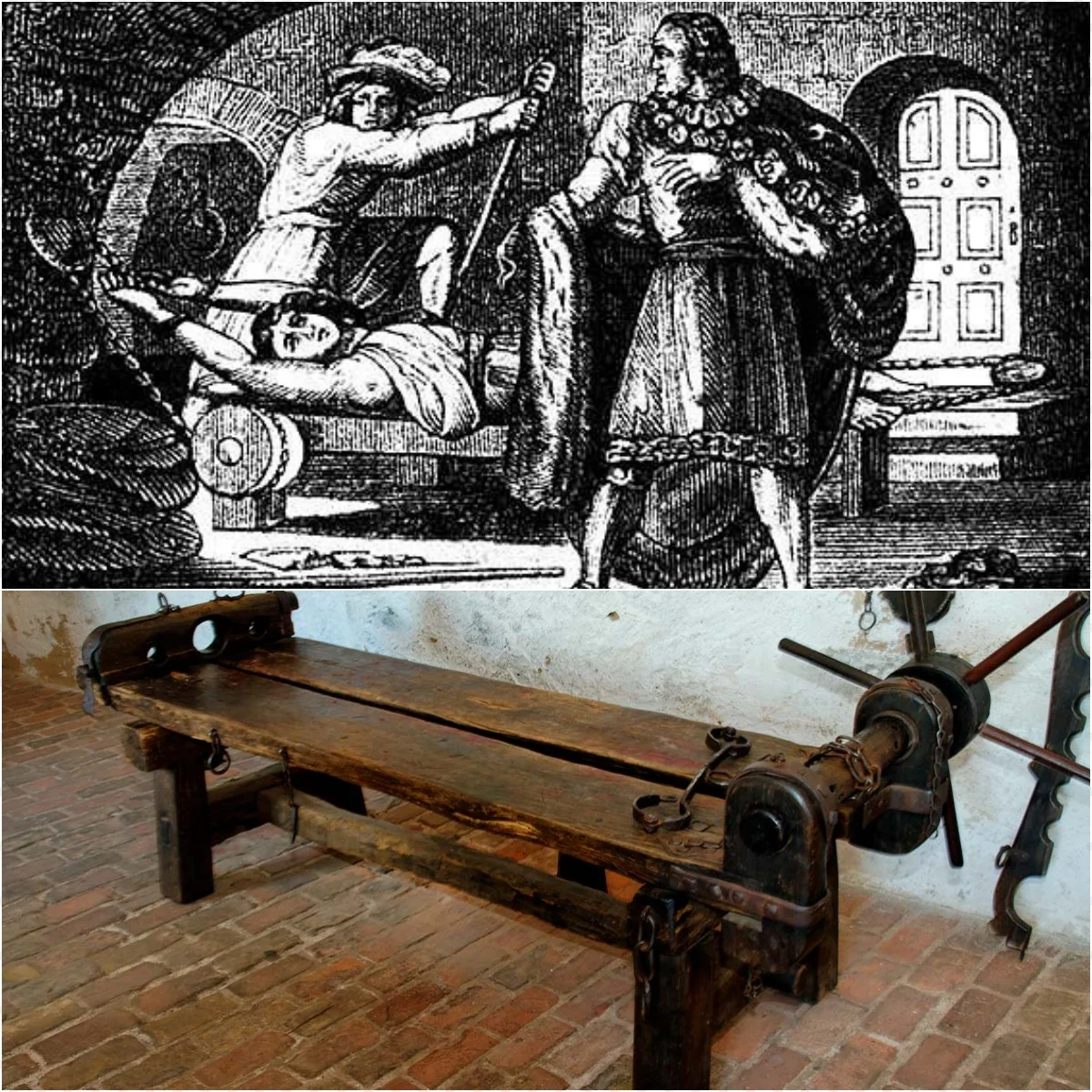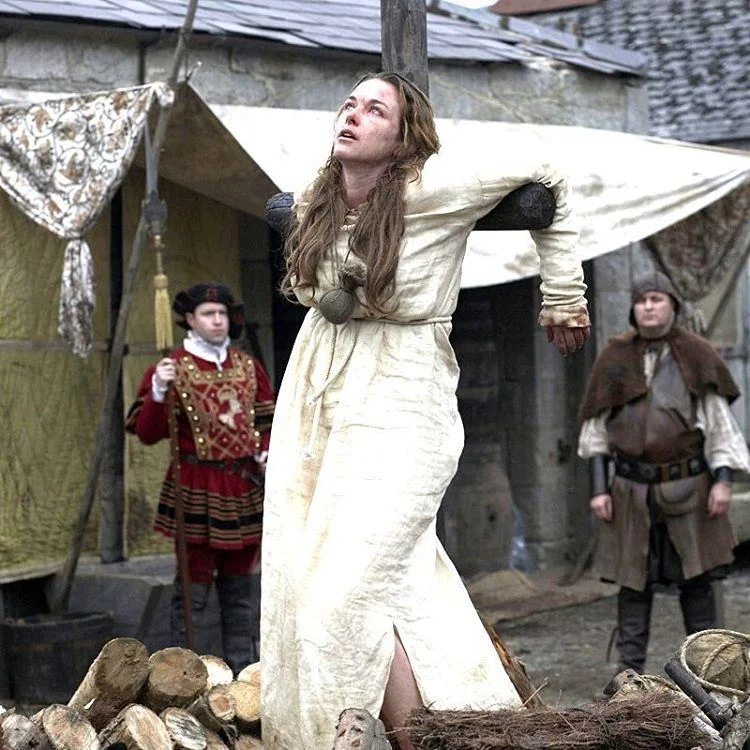HENRY VIII’S FINAL VICTIM: The Horrifying, Tragic Tale of Anne Askew – The Courageous Woman Who Defied Tudor England’s Most Brutal Punishment.H
In the turbulent era of King Henry VIII’s reign, Anne Askew, a 25-year-old poet, writer, and Protestant preacher, emerged as a symbol of courage and faith. Known as the “Fair Gospeler,” she defied a 1543 law banning women and lower gentry from reading the Bible, reciting Protestant texts to eager London crowds. Her fearless preaching led to her arrest, brutal torture in the Tower of London, and ultimately her execution by burning on July 16, 1546—the last martyr under Henry VIII and the only woman recorded to have been tortured in the Tower. Anne’s story, marked by resilience and silence in the face of unimaginable pain, continues to captivate. Let’s explore her journey, the horrors she endured, and her enduring legacy as a Tudor heroine.

Portrait of a Heroic Woman – Anne Askew
Anne Askew: The Fair Gospeler
Anne Askew, born in 1521, was a woman of remarkable intellect and conviction in a time when such traits in women were often suppressed. As a writer and poet, she embraced the Protestant Reformation, attending secret Bible study meetings in London to share and discuss the scriptures, which resonated deeply with the public. In 1543, Henry VIII’s Act of the Advancement of True Religion made it illegal for women and men of minor gentry to read the Bible, branding such acts as heresy. Undeterred, Anne stood in towns, reciting Protestant texts to ordinary folk who flocked to hear her, earning her the title “Fair Gospeler” and a form of Tudor celebrity, as noted in historical accounts. Her defiance of the law, driven by a sense of duty to spread the Gospel, made her a target for authorities seeking to suppress Protestantism.
Arrest and Imprisonment

She is the only woman recorded to have been brutally tortured in the Tower of London.
Anne’s bold preaching inevitably led to her arrest. Authorities saw her as a threat, not only for breaking the law but for her influence over London’s populace. Imprisoned in the Tower of London, a fortress synonymous with terror, Anne faced intense pressure to betray her fellow Protestants. Interrogators demanded she name other “heretics,” including prominent figures like Henry VIII’s sixth wife, Katherine Parr, who was known to favor Protestant ideas. Anne’s refusal to comply showcased her unwavering commitment to her faith and community. Her silence, even under the threat of torture, underscored her as a figure of extraordinary moral strength, setting the stage for the horrific ordeal that followed.
Torture in the Tower
Anne’s refusal to name names led to one of the most harrowing episodes of her life: torture on the rack in the Tower of London. According to her own account, she was stripped to her shift, tied to the rack, and stretched until her tendons snapped, dislocating her wrists, ankles, elbows, hips, and knees. Raised five inches off the table, she endured such agony that she passed out, only to be revived and tortured twice more. The Tower constable, Anthony Kingston, was so appalled by the brutality that he pleaded with the King to stop it, a rare act of dissent in a regime known for its ruthlessness. Anne’s torture, unique as the only recorded instance of a woman enduring the rack in the Tower, highlights the extreme measures taken to silence her. Yet, her resolve remained unbroken, a testament to her courage.
Execution and Legacy
On July 16, 1546, Anne Askew was condemned to die by burning at the stake, the standard punishment for heretics. Her torture had left her unable to stand, with snapped tendons and dislocated joints, forcing her to be carried to the execution site in a chair. Chained to a seat atop a woodpile, she faced a deliberately slow-burning fire designed to maximize suffering. Some accounts suggest a sympathetic onlooker covered her in gunpowder to hasten her death, while others claim the fire burned for over an hour, drawing crowds to witness the demise of the Fair Gospeler. Through it all, Anne maintained her dignity, never betraying her fellow Protestants. Her execution, the last under Henry VIII, cemented her as a martyr whose courage inspired future generations of reformers.

Her life became the inspiration for a famous film.
The Historical Context
Anne’s story unfolds against the backdrop of Henry VIII’s volatile reign, marked by religious upheaval. The 1543 law was part of his effort to control the spread of Protestantism, which threatened the Catholic establishment and his authority. Anne’s defiance, preaching to eager crowds, challenged not only religious norms but also gender roles, as women were expected to remain silent on matters of faith. Her connection to Katherine Parr, a reformist queen, placed her in a dangerous web of political intrigue, as factions at court vied for power. The brutality of her torture and execution reflects the era’s intolerance for dissent, yet Anne’s refusal to yield made her a symbol of resistance, as noted in historical texts like Foxe’s Book of Martyrs.

The Bigger Picture
Anne Askew’s martyrdom resonates beyond her time, illustrating the cost of standing for one’s beliefs in the face of oppression. Her story highlights the intersection of faith, gender, and power in Tudor England, where a young woman’s voice could shake the foundations of authority. The crowds that flocked to hear her and witness her execution, as recorded in contemporary accounts, show the public’s hunger for reform and admiration for her bravery. Her legacy endures in Protestant narratives, inspiring movements for religious freedom and women’s agency. In today’s context, Anne’s courage mirrors modern struggles for free expression, making her a timeless figure. Posts on X often cite her as a “forgotten heroine,” with users like @TudorHistoryFan praising her defiance, reflecting her lasting impact.
Challenges and Resilience
Anne faced immense challenges: a patriarchal society that restricted women’s roles, a legal system that criminalized her faith, and physical torture designed to break her spirit. Her small stature and youth—she was only 25—made her endurance all the more remarkable. The psychological toll of repeated torture, coupled with the knowledge of her impending death, tested her resolve, yet she never wavered. The slow-burning fire, intended to prolong her suffering, was a final act of cruelty, but her silence protected her allies, including Katherine Parr, who outlived Henry VIII. Anne’s ability to maintain dignity under such conditions challenges modern readers to consider the strength required to defy tyranny.
Anne Askew’s horrific death on July 16, 1546, marked the end of a life defined by courage and conviction. As the Fair Gospeler, she defied Henry VIII’s oppressive laws, preached to the masses, and endured unimaginable torture without betraying her faith or friends. Her story, from secret Bible meetings to the flames of Smithfield, is a powerful reminder of the cost of standing for truth. As we reflect on her legacy, let’s celebrate her as a Tudor heroine whose light burned bright even in darkness.




